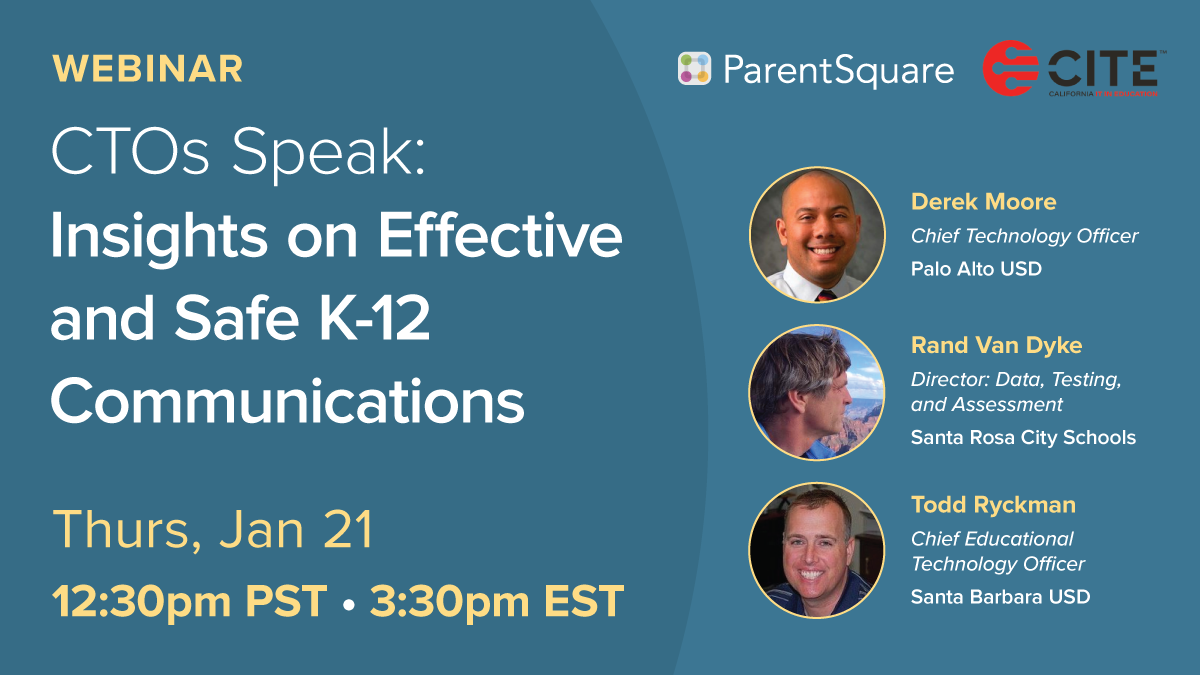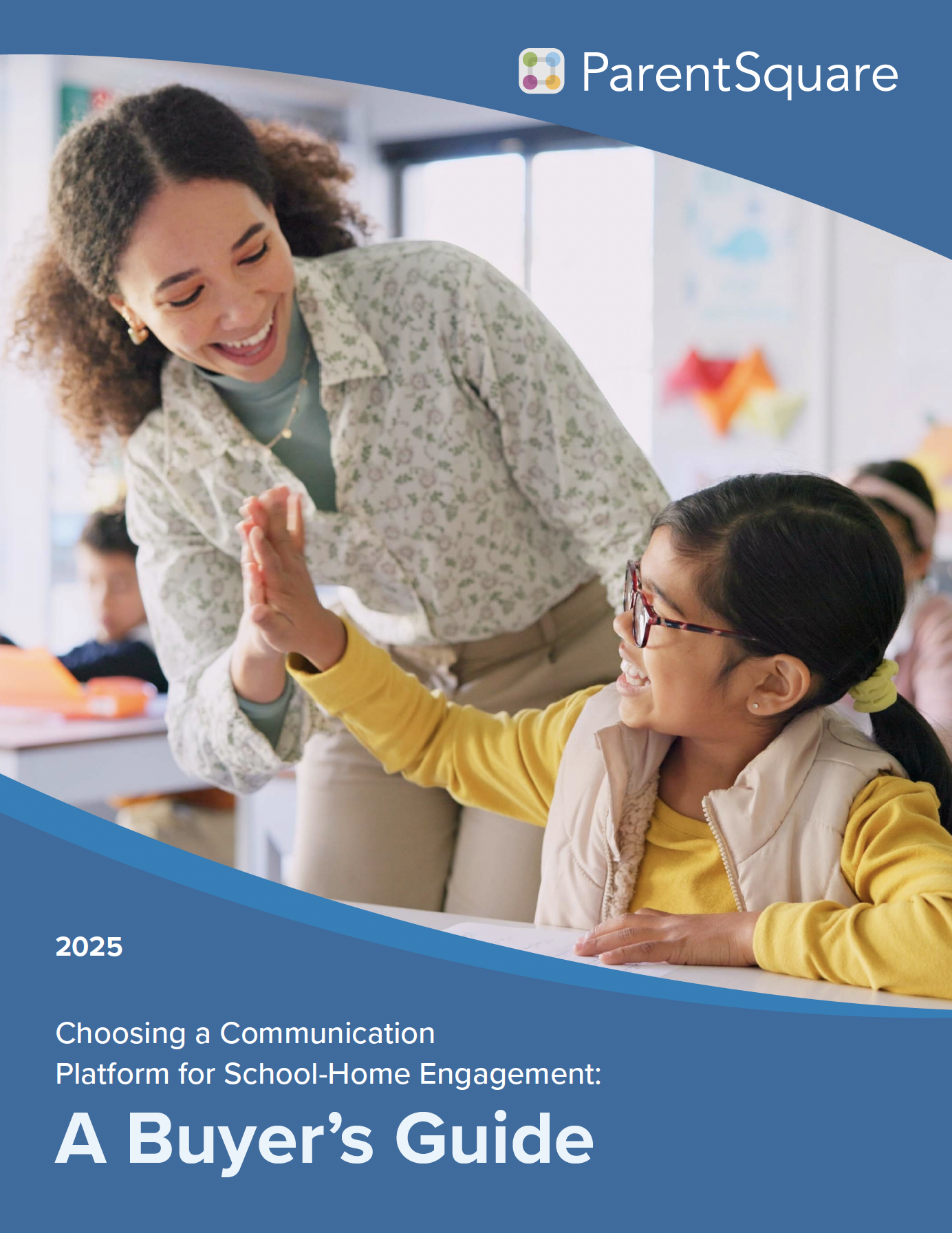
How are K-12 Technology leaders supporting great school-home connections? In January, we heard from three district leaders, Derek Moore, CTO of Palo Alto USD, Todd Ryckman, Chief Educational Technology Officer of Santa Barbara USD, and Rand Van Dyke, Director: Data, Testing, and Assessment for Santa Rosa City Schools.
Each shared how their districts tackle various school-home communications issues from a technology standpoint, including what they’re doing to close the digital equity gap, pandemic-related comms challenges, and also discussed privacy and security processes and best practices, among other topics.
Here are many of the powerful takeaways from their discussion during our “CTOs Speak: Insights on Effective and Safe K-12 Communications” webinar.
Q: How does your district ensure equitable school-to-home communications in light of the past year?
Everyone agreed that it’s been challenging to reach every family due to school closures and remote learning scenarios. Facing language barriers, landline-only households, and families in unstable housing situations, they have all had to rethink their communication methods and find new ways to reach families and close the digital equity gap. It is an ongoing challenge that districts work on regularly.
Mr. Ryckman shared that their approach to school-home communications includes having a clear communication plan for reaching every family. His district established the Family Engagement Unit to ensure all families are connected. After communicating digitally, the Family Engagement Unit steps in to communicate with those, for example, who prefer a personal call in Spanish from someone they know or those that are tech-shy and rarely use email, apps, or texting.
“We regularly look at the dashboard within ParentSquare to see what our reach is, to see who we are not getting to. And then our Family Engagement Unit will separately reach out to those families to make sure that we’re hitting everyone.”—Todd Ryckman, Chief Educational Technology Officer, Santa Barbara USD
Q: What are some of the communications challenges you’ve been tackling due to the pandemic?
Panelists agreed that it’s nearly impossible to please all parents. Some say that you’re sending too much information, while others simultaneously say that you’re not sending enough information home. It can be challenging to organize communications, so they meet the needs of every parent. Having a platform that provides reporting and dashboards is invaluable when it comes to monitoring contactability.
Mr. Van Dyke expressed that having a unified communications platform helped immensely. Previously, teachers used different communication tools, and it was difficult for parents to keep up. The ParentSquare platform helped “plug all the gaps” and smooth out pockets of over-communication and under-communication.
“The pandemic was a great reason to cut our cord on the old system and do something that allows us to get better metrics on who’s receiving, get better metrics on who isn’t contactable, get better communication back and forth with the automatic translation…so I used the pandemic as an excuse to completely change what we were doing in terms of how we were doing direct communication to families and one-to-one communication.”— Rand Van Dyke, Director: Data, Testing, Assessment, Santa Rosa City Schools

Mr. Moore experienced the same motivation to improve communications because of the challenges brought on by the pandemic. Palo Alto Unified is back in-person with a hybrid model and rolled out daily Health Screenings through ParentSquare. After getting up and running, they’ve noticed improvements in their overall communication. Derek expressed he is grateful for:
“The opportunity to move the communications pieces into the same platform so that it’s one less thing that we’re doing as an organization as we consolidate other pieces and try to have a more coherent functioning organization that is easy for everybody to interact with.” — Derek Moore, CTO, Palo Alto USD
Q: How are you balancing security, privacy, and the need for strong school-to-home engagement?
Panelists agreed that security and privacy were top priorities for their schools and districts. They have all implemented procedures to protect students and staff.
Mr. Moore stated that keeping contact data up to date and removing student or staff users when they leave is fundamental if you want to maintain a secure network. Palo Alto Unified revokes access automatically to ensure unauthorized users do not continue accessing school information.
Mr. Ryckman commented that teachers and coaches are not allowed to text students using personal devices or apps. Instead, they send direct messages through ParentSquare that get delivered to the secure StudentSquare app. Using a secure, archived work platform protects everyone by providing a paper trail of all communications between staff and students.
“The real benefit of standardizing on a single platform like ParentSquare is the idea of security and privacy and the ability to go back in and look at the messages that were sent between teachers and students, or families and students.”—Todd Ryckman, Chief Educational Technology Officer, Santa Barbara USD
The discussion then moved to the common worry from teachers that the district will monitor what they’re saying. Mr. Van Dyke suggested addressing concerns by pointing out that this set up protects teachers as much as it protects students. The panel agreed that enabling administrators to pull up all communications with a student or a parent has helped resolve situations much more easily.
“This a tool that protects both directions…it can absolutely help the teacher in a situation.” — Rand Van Dyke, Director: Data, Testing, Assessment, Santa Rosa City Schools
Q: Have there been any positive effects on school communications as a result of this past year?
Mr. Van Dyke shared that the pandemic “pushed them into the current century” because it forced educators to use new technological tools in the classroom: motivation was high!
Similarly, Mr. Ryckman finds that his district began using ParentSquare functionality that they hadn’t used before the pandemic, such as surveys and electronic signatures. He observes that Santa Barbara Unified has significant contact with families despite ongoing school closures.
“Back in the day parents were required to come and get information, they had to pull information from school districts (going to a website or things of that nature). What we really like about ParentSquare is the ability to push information. So we can send things as a phone call, as an email, as a text, or as a push notification…we know that we are able to reach a lot of our families.”—Todd Ryckman, Chief Educational Technology Officer, Santa Barbara USD
Mr. Moore’s district also found a silver lining in the past year. Before the pandemic, schools in the district weren’t operating as a cohesive unit but instead doing everything individually across 18 school sites. For him, ParentSquare has been a positive shift towards an organization that functions as one unified body.
“We have historically been an extremely decentralized organization, with just about everything happening individually at each school site, across our 18 different district sites, which obviously makes a huge challenge from the district perspective. Managing that challenge is one of the positive things we’ve seen throughout the past 10-11 months—a shift back to more cohesion and more functioning as a larger organization.” — Derek Moore, CTO, Palo Alto USD

CTO, PALO ALTO USD
It’s clear that exploring new technologies such as a unified school-home communications platform like ParentSquare, or simply leveraging its functionalities to meet districts’ ongoing needs during the pandemic has positively impacted all participants’ communities. It also highlights the versatility of a unified communications platform, which schools or districts can use as much or as little as needed, with the option to add or remove functionalities.
That lead panelists to discuss what they’re currently succeeding at in terms of school-home communications and offered insight into what other schools or districts could try to optimize their comms.
Q: What tactics and strategies are working for you for communications that other schools or districts could try?
The panelists all agreed that having a unified communications platform like ParentSquare was vital and absolutely worth implementing. They shared their strategies for managing this kind of change, which often can result in pushback from staff who do not want to (or don’t have the time to) learn new technologies.
Mr. Ryckman recalled how teachers were initially apprehensive about learning a new technology and adding something else to their plate. They focused on how ParentSquare would save time for teachers, make their lives easier, and managed a ‘soft’ introduction. Once some teachers adopted it voluntarily and saw significant benefits, others started using it, causing a domino effect.
Mr. Van Dyke echoed Mr. Ryckman’s approach. Though they implemented ParentSquare district-wide, it was not mandated. Now, he finds that teachers are chasing them on their first day on the job to get a ParentSquare account!
“ParentSquare is growing as a tool that teachers want to have.” — Rand Van Dyke, Director: Data, Testing, Assessment, Santa Rosa City Schools
By focusing on the positives that new technology can offer and positioning the platform to show how it can make everyone’s lives and jobs easier, staff is more likely to get onboard. Of course, providing set-up, training, and ongoing support is another way to garner staff buy-in for new tech tools.
Q: What did your communications look like before and after using ParentSquare?
Mr. Moore expressed that his district is still very new to ParentSquare, but the Health Screening feature has been extremely helpful for his district! They are also motivated to use ParentSquare to ensure communications are effective.
“The driver for us with something like ParentSquare has really been around making sure our communication is getting to people the way that they want it. Largely, most of our past communications have been email or posting on our website, which there’s really not a lot of feedback on.” — Derek Moore, CTO, Palo Alto USD
He further explained that starting on a smaller scale and leveraging early adopters helped his district get off to a successful start.
Mr. Van Dyke discussed using their platform to target communications to specific groups, something they could not do before adopting a unified comms platform. One example of targeted messaging is to group students who may have been exposed to COVID-19 and then contact parents accordingly. Their previous communications were mainly one-way broadcasts to families, completely different from the much more effective two-way communications and one-to-one communication that is possible now.
“The old telephone system was the primary method we communicated with…it wasn’t one-to-one or one-to-small groups, it was typically one to entire site or one-to-entire district using a phone dialing system…it’s night and day different.” — Rand Van Dyke, Director: Data, Testing, Assessment, Santa Rosa City Schools
Mr. Ryckman added:
“Our communication was very decentralized…now school sites still have the flexibility to send out messages whenever they want, but we have visibility into that, we can look at how much messaging is going out.”
“We can really really get down to exactly the families we need to reach, rather than blasting things out to everyone…we’re sending messages to exactly who needs to get it.”—Todd Ryckman, Chief Educational Technology Officer, Santa Barbara USD

CHIEF EDUCATIONAL TECHNOLOGY OFFICER, SANTA BARBARA USD
Technology is a critical piece of the puzzle to keep staff and students connected, engaged, and informed and tech officers across the nation have stepped up to the plate to help ensure instruction continuity with the various learning scenarios. Many have also been tasked with re-imagining and refining how effective school-home communications look, yet another undertaking the pandemic has spurred upon this important role that we continue to see.
We thank our CTO panelists for the amazing tips and thoughtful insight they provided!
Posted Wednesday, February 3, 2021







